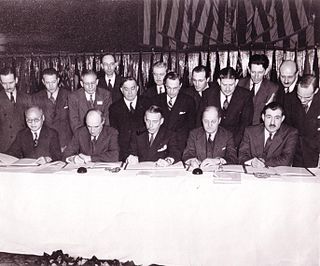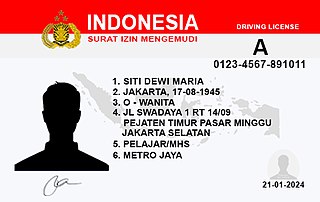
Traffic comprises pedestrians, vehicles, ridden or herded animals, trains, and other conveyances that use public ways (roads/sidewalks) for travel and transportation.

A vehicle registration plate, also known as a number plate or license plate or licence plate, is a metal or plastic plate attached to a motor vehicle or trailer for official identification purposes. All countries require registration plates for road vehicles such as cars, trucks, and motorcycles. Whether they are required for other vehicles, such as bicycles, boats, or tractors, may vary by jurisdiction. The registration identifier is a numeric or alphanumeric ID that uniquely identifies the vehicle or vehicle owner within the issuing region's vehicle register. In some countries, the identifier is unique within the entire country, while in others it is unique within a state or province. Whether the identifier is associated with a vehicle or a person also varies by issuing agency. There are also electronic license plates.

The country in which a motor vehicle's vehicle registration plate was issued may be indicated by an international vehicle registration code, also called Vehicle Registration Identification code or VRI code, formerly known as an International Registration Letter or International Circulation Mark. It is referred to as the Distinguishing sign of the State of registration in the Geneva Convention on Road Traffic of 1949 and the Vienna Convention on Road Traffic of 1968.

The Convention on International Civil Aviation, also known as the Chicago Convention, established the International Civil Aviation Organization (ICAO), a specialized agency of the United Nations charged with coordinating international air travel. The Convention establishes rules of airspace, aircraft registration and safety, security, and sustainability, and details the rights of the signatories in relation to air travel. The convention also contains provisions pertaining to taxation.
A vehicle registration plate, also known as a number plate, license plate or licence plate, is a metal or plastic plate or plates attached to a motor vehicle or trailer for official identification purposes. The registration identifier is a numeric or alphanumeric code that uniquely identifies the vehicle within the issuing authority's database. In Europe most countries have adopted a format for registration plates that satisfies the requirements in the Vienna Convention on Road Traffic, which states that cross-border vehicles must display a distinguishing code for the country of registration on the rear of the vehicle. This sign may be an oval sticker placed separately from the registration plate, or may be incorporated into the plate. When the distinguishing sign is incorporated into the registration plate, it must also appear on the front plate of the vehicle, and may be supplemented with the flag or emblem of the national state, or the emblem of the regional economic integration organisation to which the country belongs. An example of such format is the common EU format, with the EU flag above the country code issued in EU member states.
A driver's permit, learner's permit, learner's license or provisional license is a restricted license that is given to a person who is learning to drive, but has not yet satisfied the prerequisite to obtain a driver's license. Having a learner's permit for a certain length of time is usually one of the requirements for applying for a full driver's license. To get a learner's permit, one must typically pass a written permit test, take a basic competency test in the vehicle, or both.

An International Driving Permit (IDP), often referred to as an international driving license, is a translation of a domestic driving license that allows the holder to drive a private motor vehicle in any country or jurisdiction that recognises the document. The term International Driving Permit was first mentioned in the document prescribed in the International Convention relative to Motor Traffic that was signed at Paris in 1926, and is a translation of the French 'permis de conduire international', or 'international driving license'. The Paris treaty, and all subsequent, use the word 'permit' exclusively in relation to all kinds of driving license.

The European driving licence is a driving licence issued by the member states of the European Economic Area (EEA); all 27 EU member states and three EFTA member states; Iceland, Liechtenstein and Norway, which give shared features the various driving licence styles formerly in use. It is credit card-style with a photograph. They were introduced to replace the 110 different plastic and paper driving licences of the 300 million drivers in the EEA. The main objective of the licence is to reduce the risk of fraud.
In India, a driving licence is an official document that authorises its holder to operate various types of motor vehicles on highways and some other roads to which the public has access. In various Indian states, they are administered by the Regional Transport Authorities/Offices (RTA/RTO). A driving licence is required in India by any person driving a vehicle on any highway or other road defined in the Motor Vehicles Act, 1988. This act sets limits on the minimum age for vehicle operation ranging from 16 to 20, depending on specific circumstances. A modern photo of the driving licence can also serve many of the purposes of an identity card in non-driving contexts, such as proof of identity or age.
In Pakistan, the driving licence is the official document which authorises its holder to operate various types of motor vehicles on publicly accessible roads. Driving licences can be obtained by submitting an application to any licensing authority in the applicant's district.
A driving licence in Singapore is required before a person is allowed to drive a motor vehicle of any description on a road in the country. Like many other countries in the world, an individual must possess a valid driving licence before being permitted to drive on the road, and driving licence holders are subject to all traffic rules.
In Taiwan, driver's licenses (駕駛執照) are issued by the Ministry of Transportation and Communications to a qualified motor vehicle driver. The number on a license is the same as the ID number of the license holder's household registration in Taiwan. In Taiwan, the license is sometimes accepted as a valid identity document, as its information replicates most of what is on a National Identification Card.

In the United Kingdom, a driving licence is the official document which authorises its holder to operate motor vehicles on highways and other public roads. It is administered in England, Scotland and Wales by the Driver and Vehicle Licensing Agency (DVLA) and in Northern Ireland by the Driver & Vehicle Agency (DVA). A driving licence is required in England, Scotland, and Wales for any person driving a vehicle on any highway or other "road", as defined in s.192 Road Traffic Act 1988, irrespective of the ownership of the land over which the road passes. Similar requirements apply in Northern Ireland under the Road Traffic Order 1981.
Vehicle registration plates in Northern Ireland use a modified version of the British national registration plate system that was initiated for the whole of the United Kingdom of Great Britain and Ireland in 1903. Originally, all counties in the UK were allocated two identification letters. At that time, the whole of Ireland was in the UK, and the letters I and Z were reserved for the Irish counties. The 'I' series was used first, but by the time it came to using the 'Z' series in 1926, the Irish Free State had already come into existence, and so it was agreed that the Northern Ireland would use the AZ – YZ series, while the Free State would use the ZA – ZZ series. In 1987, the Republic of Ireland broke away from the system altogether. As of 2002 there were reportedly 794,477 recorded registration plates in Northern Ireland, compared to only 50 for the island as a whole when the format was first introduced in 1903.

The Convention on Road Traffic, commonly known as the Geneva Convention on Road Traffic, is an international treaty promoting the development and safety of international road traffic by establishing certain uniform rules among the contracting parties. The convention addresses minimum mechanical and safety equipment needed to be on board and defines an identification mark to identify the origin of the vehicle. The Convention was prepared and opened for signature by the United Nations Conference on Road and Motor Transport held at Geneva from 23 August to 19 September 1949. It came into force on 26 March 1952. This conference also produced the Protocol on Road Signs and Signals.
The Inter-American Driving Permit (IADP) is an identity document that licenses the holder to drive a private motor vehicle in another nation when accompanied by a valid license from their home country. The IADP is similar to the International Driving Permit (IDP), but is specific to drivers in North, Central, and South America. To be eligible for an IADP, one must first have a valid driver's license. The IADP might not be issued by all countries in the Americas, due to most of them being parties of the 1949 Geneva Convention or the 1968 Vienna Convention, thus most only issue the IDP.

A driving licence is required in Malaysia before a person is allowed to drive a motor vehicle of any description on a road in Malaysia under the Road Transport Act 1987, section 26(1). Under section 26(1) of the Road Transport Act, an individual must possess a valid driving licence before being permitted to drive on the road, or can be prosecuted under section 26(2). Upon conviction, the miscreant is liable to fines or jail or both. Driving licence holders are subject to all traffic rules stated in the Road Transport Act 1987.

The Indonesian driving license is a legal document required for a person to be allowed to drive a motor vehicle in Indonesia. It is issued by the Indonesian National Police (POLRI), renewable every 5 years, and is valid in all ASEAN member states without an International Driving Permit. Driving license holders are subject to all Indonesian road rules and regulations. There is no provisional driving license in Indonesia.
Vehicle registration plates are the alphanumeric plates used to display the registration mark of a vehicle, and have existed in the United Kingdom since 1904. It is compulsory for motor vehicles used on public roads to display vehicle registration plates, with the exception of vehicles of the reigning monarch used on official business.

A driver's license, driving licence, or driving permit is a legal authorization, or the official document confirming such an authorization, for a specific individual to operate one or more types of motorized vehicles—such as motorcycles, cars, trucks, or buses—on a public road. Such licenses are often plastic and the size of a credit card.















